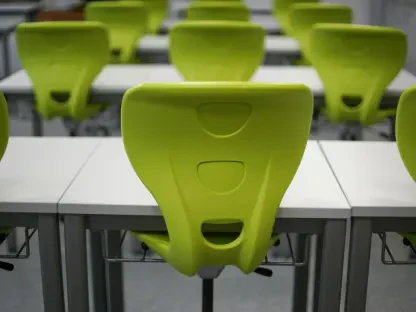Camille Faivre is known for her expertise in education management, particularly her focus on developing and implementing open and e-learning programs. With the education sector still grappling with post-pandemic financial restraints, Camille’s insights into asset management and finance leasing offer innovative solutions for schools looking to optimize their budgets and safeguard staffing.
Can you tell us a bit about your background and your role at Grenke UK?
I have been involved in asset management for several years, which has provided me with a deep understanding of financial solutions suitable for various sectors, including education. At Grenke UK, I assist institutions in developing strategies for sustainable financial management, focusing on asset leasing as a key approach to managing budgets effectively. My background has been instrumental in guiding schools through financial challenges, particularly in the post-pandemic landscape.
How did your expertise in asset management influence your approach as a school governor?
My expertise in asset management allowed me to bring a business-oriented perspective to the school’s financial challenges. Approaching the school’s finances with a strategic mindset, I aimed to introduce structured financial solutions like leasing to better manage costs and optimize resources. This business-focused mindset was crucial in stabilizing the school’s finances and ensuring that essential resources and staff were protected.
What extreme financial difficulties did your local primary school face in 2020?
In 2020, our local primary school faced severe budget constraints due to reduced funding and increasing operational costs. We were in a position where making staff redundancies seemed inevitable, and we struggled to allocate resources for essential equipment like IT systems and security upgrades. The financial turmoil was significant and required immediate and effective solutions.
What were the initial steps you took to address these financial challenges?
Firstly, I collaborated with the school’s leadership to thoroughly analyze our financial position and identify critical areas where costs could be managed more efficiently. We then explored various financial solutions and I introduced the concept of asset leasing as a means to alleviate immediate budget pressures. This involved extensive discussions and planning to demonstrate the practicality and benefits of leasing over purchasing assets outright.
Can you explain what leasing is and why it’s beneficial for schools?
Leasing is essentially a financial arrangement where schools can use assets like computers or security systems without needing to make substantial upfront payments. Instead, the cost is spread over the useful life of the asset through regular lease payments. This approach allows schools to access essential resources while maintaining financial flexibility, which is particularly beneficial when dealing with restricted budgets.
Why do you think there’s a general lack of understanding about leasing in schools?
Many school leaders haven’t been exposed to the benefits of leasing, often because traditional funding methods have been the norm. There’s also a level of skepticism and caution, possibly due to a lack of information and previous experiences with other financial products. Overcoming this requires education and clear examples of successful leasing implementations to build trust and understanding.
How did you go about convincing your school leadership of leasing’s potential?
Convincing the school leadership required demonstrating concrete benefits. I provided detailed comparisons showing how leasing would optimize cash flow and reduce the immediate financial burden. Moreover, I shared successful case studies and worked closely with the leadership to address their concerns, ensuring transparency and ethical practices throughout the process.
How does leasing make school assets more affordable and accessible?
Leasing spreads the asset cost over several years, which reduces the need for capital outlay. This makes it easier for schools to afford and access different types of equipment without straining their budgets. Leasing provides a structured way to manage payments over time, which is a significant advantage compared to the upfront costs of purchasing.
What kinds of assets can schools lease through financial leasing?
Schools can lease a wide range of assets, including IT systems (like computers and interactive whiteboards), security infrastructure (such as CCTV and access control systems), and other essential equipment (like photocopiers). This flexibility allows schools to acquire the latest resources needed for effective educational delivery without heavy financial investment.
What are some advantages of leasing compared to buying equipment outright?
The primary advantage is the ability to manage cash flow more efficiently by distributing the cost over the asset’s useful life. This means schools don’t have to compromise on acquiring necessary resources. Additionally, leasing often includes maintenance and upgrade options, ensuring that schools always have access to up-to-date technology and equipment.
Can you elaborate on the findings from Grenke’s recent survey titled “New Lease of Life”?
The survey highlighted that a significant percentage of educational institutions are operating with suboptimal equipment due to financial constraints. Surprisingly, the uptake of leasing was lower in schools compared to the national average for SMEs. This indicates a gap in the adoption of leasing as a viable financial solution in the education sector.
Why do you think the uptake of leasing in schools is lower than the national average?
This lower uptake is likely due to a combination of factors, including lack of awareness, reluctance to deviate from traditional funding methods, and possibly misconceptions about the leasing process. Encouraging a shift requires comprehensive information campaigns and showcasing the real-world benefits and successes of leasing.
How does leasing unlock budgets to protect staffing levels?
By spreading the costs of essential assets, leasing frees up significant portions of the budget that would otherwise be tied up in upfront purchases. These freed-up funds can then be redirected towards critical areas, such as maintaining or even increasing staffing levels, which directly impacts the quality of education.
How did leasing help your school avoid staff redundancies?
Leasing allowed us to reallocate funds that were initially set aside for capital expenditures. This reallocation meant we could maintain the teaching staff required to provide a high standard of education, even amid financial pressures. By avoiding hefty upfront purchases, we sustained our staff and continued investing in essential educational resources.
How does leasing affect budget planning and cash flow?
It significantly eases budget planning because the payments are predictable and spread out. This predictability aids in better cash flow management, allowing schools to balance their books more effectively and plan for future expenditures without unexpected financial strain.
How did you find the best leasing deal for your school?
We conducted a thorough market analysis and engaged with trusted leasing partners to ensure transparency and ethical practices. This involved comparing different offers, understanding the terms, and choosing a deal that provided the best value while aligning with the school’s financial strategy.
What were the end-of-lease options available, and how do they benefit the school?
At the end of the lease term, we had several options: renew the lease, return the asset, or upgrade to newer technology. Each option is designed to offer flexibility and help the school stay technologically current without the financial burden of buying new equipment outright.
Can you share some specific outcomes from your school’s use of leasing?
Through leasing, we have consistently maintained up-to-date educational tools and technology. This has positively impacted the teaching environment and learning outcomes. Financially, we’ve remained stable and avoided staff redundancies, leading to a more resilient and motivated teaching staff.
How can other schools replicate your success with leasing?
Other schools can start by educating their leadership about the benefits of leasing and evaluating their current financial strategies. Partnering with reliable leasing companies and conducting thorough market research would also be crucial steps. Open dialogues about financial constraints and potential solutions can pave the way for successful implementation.
What advice would you give to school leaders who are skeptical of leasing?
I would encourage them to look beyond the traditional financial methods and consider the long-term benefits of leasing. By showcasing successful examples and providing detailed financial plans, school leaders can see how leasing can transform their budgeting strategy and resource management.









